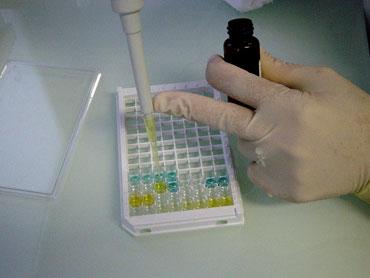 Proteins are made of amino acids. It can be components of the cell wall or have a function in the cell, like enzymes or storage proteins.
Proteins are made of amino acids. It can be components of the cell wall or have a function in the cell, like enzymes or storage proteins.
Proteins are coded by genes and can be species specific. Proteins remain however thermosensitive and are denaturated by excessive heating.
Proteins are close to the cell functions, and therefore directly connected to an expected property, like for example allergens.
Proteins are easily recognized by the immune system and so may be detectable by the antibodies that bring a high specificity.
The ELISA sandwich technique, for Enzyme Linked Immuno Sorbent Assay, uses a first antibody which is specific of the searched protein. This antibody is immobilized on a plastic support and will catch the searched protein. In a second step, a second antibody coupled to an enzyme (a conjugate) is fixed on the searched protein. In a third step, a substrate is added which is split to a chromogenic product.
This type of test is fast and easy to be processed in a specialized laboratory provided that many cautions are integrated. It has the inconvenient in a complex foodstuff to lack specificity according to the detected proteins and to lack sensitivity due to matrix effects.
Indeed, the complex matrixes induce displacement effects of the plastic coated antibodies that generate false positive results. This is not the guarantee of an acceptable specificity.
The detection limit is in the range 1 to 10 ppm of the detected species.
The competition ELISA technique uses a target protein coated on a plastic support detected by a conjugate (second specific antibody linked to an enzyme) which is revealed by a chromogenic substrate.
This detection system is compared to a solution where a sample has been pre-incubated with the conjugate.
The conjugate is so blocked by the target protein and is not revealed by the system. So the more target protein is in the sample the less signal is revealed, the reason why it is called competition ELISA